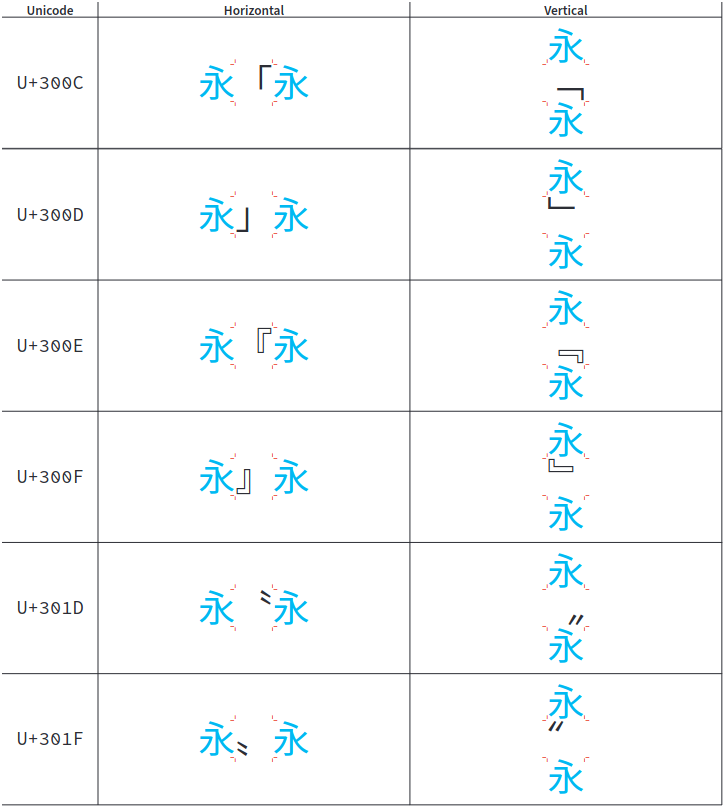|
East Asian Punctuation (other)
East Asian punctuation can refer to: * Chinese punctuation * Japanese punctuation * Korean punctuation * CJK Symbols and Punctuation (Unicode block) * Halfwidth and Fullwidth Forms (Unicode block) {{Disambig ... [...More Info...] [...Related Items...] OR: [Wikipedia] [Google] [Baidu] |
Chinese Punctuation
Writing systems that use Chinese characters also include various punctuation marks, derived from both Chinese and Western sources. Historically, ''jùdòu'' () annotations were often used to indicate the boundaries of sentences and clauses in text. The use of punctuation in written Chinese only became mandatory during the 20th century, due to Western influence. Unlike modern punctuation, ''judou'' marks were added by scholars for pedagogical purposes and were not viewed as integral to the text. Texts were therefore generally transmitted without ''judou''. In most cases, this practice did not interfere with the interpretation of a text, although it occasionally resulted in ambiguity. The first book to be printed with modern punctuation was ''Outline of the History of Chinese Philosophy'' () by Hu Shih, published in 1919. Traditional poetry and calligraphy maintains the punctuation-free style. However, most editions of classical texts published since the 1930s are punctuated with f ... [...More Info...] [...Related Items...] OR: [Wikipedia] [Google] [Baidu] |
Japanese Punctuation
includes various written marks (besides characters and numbers), which differ from those found in European languages, as well as some not used in formal Japanese writing but frequently found in more casual writing, such as exclamation and question marks. Japanese can be written horizontally or vertically, and some punctuation marks adapt to this change in direction. Parentheses, curved brackets, square quotation marks, ellipses, dashes, and swung dashes are rotated clockwise 90° when used in vertical text ( see diagram). Japanese punctuation marks are usually "full width" (that is, occupying an area that is the same as the surrounding characters). Punctuation was not widely used in Japanese writing until translations from European languages became common in the 19th century. Japanese punctuation marks Brackets Various types of are used in Japanese. As in English, brackets are used in pairs to set apart or interject text within other text. When writing vertically ... [...More Info...] [...Related Items...] OR: [Wikipedia] [Google] [Baidu] |
Korean Punctuation
For the Korean language, South Korea mainly uses a combination of East Asian and European punctuation, while North Korea uses more of the East Asian punctuation style. Traditional punctuation In the traditional Korean system of writing, which was largely based on the Chinese writing system, punctuation was primarily used to make corrections or to help with the understanding of hanja, or Chinese characters. Some of the corrective punctuation marks included ⟨◦⟩ called 끼움표 (''kki-umpyo''), which was used for inserting, and ⟨▯⟩ called 삭제부 (''sakjebu'') which was used for deleting. The traditional writing system known as gugyeol, used punctuation to interpret Chinese characters in a way Korean speakers could understand. One of the marks used in gugyeol was a dot ⟨•⟩ called 역독점 (''yeokdokjeom''), which was used to indicate reading order. The conclusion of an idea or thought was indicated by starting a new line of characters from the top, as opposed ... [...More Info...] [...Related Items...] OR: [Wikipedia] [Google] [Baidu] |
CJK Symbols And Punctuation
CJK Symbols and Punctuation is a Unicode block containing symbols and punctuation used for writing the Chinese, Japanese and Korean languages. It also contains one Chinese character. Block The block has variation sequences defined for East Asian punctuation positional variants. They use (VS01) and (VS02): Orientation Quotation marks and other punctuation have expected differences in behaviour in vertical and horizontal text. The quotation marks 「...」, 『...』 and 〝...〟 rotate 90 degrees, as follows: See also General Punctuation, for variation selectors and CJK behaviour of the Latin quotation marks ‘...’ and “...”. Chinese character The CJK Symbols and Punctuation block contains one Chinese character: . Although it is not covered under "Unified Ideographs", it is treated as a CJK character for all other intents and purposes. Emoji The CJK Symbols and Punctuation block contains two emoji: U+3030 and U+303D. The block has four standardized var ... [...More Info...] [...Related Items...] OR: [Wikipedia] [Google] [Baidu] |

